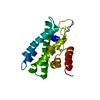+Search query
-Structure paper
| Title | Molecular mechanisms of inverse agonism via κ-opioid receptor-G protein complexes. |
|---|---|
| Journal, issue, pages | Nat Chem Biol, Vol. 21, Issue 7, Page 1046-1057, Year 2025 |
| Publish date | Jan 7, 2025 |
 Authors Authors | Aaliyah S Tyson / Saif Khan / Zenia Motiwala / Gye Won Han / Zixin Zhang / Mohsen Ranjbar / Daniel Styrpejko / Nokomis Ramos-Gonzalez / Stone Woo / Kelly Villers / Delainey Landaker / Terry Kenakin / Ryan Shenvi / Susruta Majumdar / Cornelius Gati /  |
| PubMed Abstract | Opioid receptors, a subfamily of G protein-coupled receptors (GPCRs), are key therapeutic targets. In the canonical GPCR activation model, agonist binding is required for receptor-G protein complex ...Opioid receptors, a subfamily of G protein-coupled receptors (GPCRs), are key therapeutic targets. In the canonical GPCR activation model, agonist binding is required for receptor-G protein complex formation, while antagonists prevent G protein coupling. However, many GPCRs exhibit basal activity, allowing G protein association without an agonist. The pharmacological impact of agonist-free receptor-G protein complexes is poorly understood. Here we present biochemical evidence that certain κ-opioid receptor (KOR) inverse agonists can act via KOR-G protein complexes. To investigate this phenomenon, we determined cryo-EM structures of KOR-G protein complexes with three inverse agonists: JDTic, norBNI and GB18, corresponding to structures of inverse agonist-bound GPCR-G protein complexes. Remarkably, the orthosteric binding pocket resembles the G protein-free 'inactive' receptor conformation, while the receptor remains coupled to the G protein. In summary, our work challenges the canonical model of receptor antagonism and offers crucial insights into GPCR pharmacology. |
 External links External links |  Nat Chem Biol / Nat Chem Biol /  PubMed:39775170 / PubMed:39775170 /  PubMed Central PubMed Central |
| Methods | EM (single particle) |
| Resolution | 3.0 - 3.58 Å |
| Structure data | EMDB-43556, PDB-8vve: EMDB-43557, PDB-8vvf: EMDB-43558, PDB-8vvg:  EMDB-43648: Kappa opioid receptor:Galphai protein in complex with inverse agonist JDTic, Original map receptor  EMDB-43649: Kappa opioid receptor:Galphai protein in complex with inverse agonist JDTic, Original map G protein  EMDB-43652: Kappa opioid receptor:Galphai protein in complex with inverse agonist norBNI, Original map G protein  EMDB-43653: Kappa opioid receptor:Galphai protein in complex with inverse agonist GB18, Original map receptor  EMDB-43654: Kappa opioid receptor:Galphai protein in complex with inverse agonist GB18, Original map G protein EMDB-46585, PDB-9d61: |
| Chemicals |  PDB-1ad6:  ChemComp-JDC:  PDB-1ad5: |
| Source |
|
 Keywords Keywords | MEMBRANE PROTEIN / G protein coupled receptor / Opioid receptor |
 Movie
Movie Controller
Controller Structure viewers
Structure viewers About Yorodumi Papers
About Yorodumi Papers











 homo sapiens (human)
homo sapiens (human)
